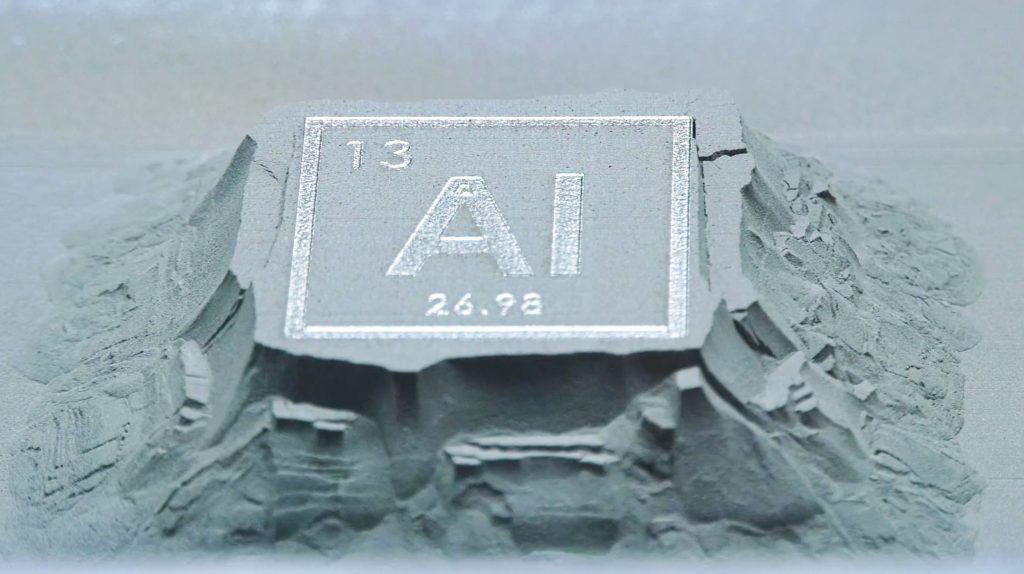In September 2017, a HRL Laboratories team published a paper announcing that they had succeeded in 3D printing a traditionally non-weldable, high-strength aluminum alloy. A feat of ingenuity, the team functionalized an incredibly crack-prone material with average yield strengths up to 580 MPa. Two years later, the material used by HRL in this experiment became the first additive manufacturing aluminum alloy registered with the historic Aluminum Association.
Known as Aluminum 7A77.60L, this metal powder for 3D printing is now available to buy directly from HRL.
By commercially releasing the material to the market, HRL has now achieved what it set out to do: “HRL’s goal in developing materials has always been to make sure designers have the opportunity to use the highest performing materials possible,” explains Hunter Martin, PhD, Chief Metallurgist at HRL Laboratories.
“7A77 is the strongest additive aluminum on the market and provides unmatched design freedom.”
A 3D printed alternative to wrought aluminum alloy
Founded in 1948, HRL Laboratories is a research facility dedicated to advancing the development of microelectronics, information & systems sciences, materials, sensors, and photonics. It is currently co-owned by General Motors Corporation and Boeing.
Aluminum 7A77.60L has been in the making at HRL since 2014. Taking Al-7075, one of the most commonly used aluminium alloys for high-stress structural applications, HRL researchers sought to create a 3D printable version that could expand the material’s application across high value sectors including aerospace, automotive and oil & gas.
Al-7075 has good ductility, high strength, toughness, good resistance to fatigue and excellent corrosion resistance. However, these properties come with a heightened susceptibility to embrittlement, making it difficult to melt or process with a laser. This was the first challenge addressed by the team at HRL. However, Martin explains, successful 3D printing “was only the first part” of the process.
“Wrought alloys have had a century to develop all the processing conditions to provide peak strength and ductility,” whereas “additive manufacturing” on the other hand “is not straightforward,” Martin adds. Due to the interconnected parameter effects of metal 3D printing processes, and SLM/DMLS being relatively new technologies, the HRL team knew that creating a commercial 7A77 with the right properties would not be simply a “textbook recipe.”
“There are a lot of people out there trying to design alloys from scratch,” Martin explains, “but 7A77 differs by really taking advantage of known and proven strengthening mechanisms.”
The main strengthening elements of low cost 7000 series alloys are Zinc, Copper and Magnesium. By striking the perfect balance between these elements, Martin notes, “we knew that we had a chemistry in 7A77 that could provide the highest performance, like its wrought counterpart 7075.” The next step, however, was “to unlock that potential with the correct processing parameters” for 3D printing.
High-strength material for every industry
By combining the perfect recipe with optimal parameters and post post processing, HRL’s research successfully unlocked an entire class of wrought alloys for 3D printing “rather than” Martin adds, “relying on cast or new alloy design.”
With 7A77, this results in the delivery of a material with average yield strengths >580 MPa and ultimate strengths >600 MPa with an average elongation of >8%. Crucially, as a derivative of 7075, 7A77 can be post processed using conventional methods already applied in manufacturing supply chains. Existing chemical polishing and anodizing equipment, for example, can be applied to 7A77 parts, therefore easing integration of additive manufacturing into conventional factories.
PBF systems from British 3D printer provider Renishaw are among the first machines to prove capable of processing 7A77. Open to new and third-party material developments “by design”, the machines allow customers like HRL “to freely develop new materials and new material parameters for alloys such as 7A77.” Stephen Anderson, Director of Group Software at Renishaw, explains that, such materials “bring significant improvement in strength while maintaining highly impressive performance in ductility.”
“Having materials such as 7A77 developed on Renishaw systems,” Anderson adds, “also allows our users to then concentrate upon further optimizing parameters for their unique production components.”
With 7075’s prevalence in aircraft construction, aerospace has naturally become the first sector to begin leveraging the high strength and geometric freedom of 7A77. According to Martin, applications so far have included the production of pressure vessels, manifolds, brackets and airframes. On-demand aircraft sustainment is also one particular area of interest, but the material still has much as-yet unexplored potential in oil and gas, automotive, and sporting goods sectors.
“The ubiquitous industrial use of wrought 7000 series alloys, means almost every industry is familiar with our material,” Martin adds, “we are just providing a new additive opportunity to improve product design.”
As strength is not the only criteria for engineering applications, HRL is now investigating further processing routes to improve the corrosion resistance, fracture toughness and fatigue resistance of 7A77. The technology used to develop in 7A77 is also being applied to the processing of 2000 and 6000 series alloys which the lab expects to release to the market in the near future.
Aluminum 7A77.60L powder for 3D printing is currently available to purchase directly from HRL.

For more of the latest 3D materials news subscribe to the 3D Printing Industry newsletter, follow us on Twitter and like us on Facebook. Seeking jobs in engineering? Make your profile on 3D Printing Jobs, or advertise to find experts in your area.
Featured image shows HRL Laboratories logo in SLM. Photo via HRL Laboratories



